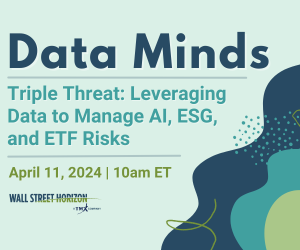Although alternative data sets are helping funds with systematic investment strategies, those funds that employ discretionary strategies are finding it harder to separate the new trading signals from the noise.
Much of it comes from the structure of the discretionary funds, which have separated their data science/quant research teams away from their portfolio managers, according to Leigh Drogen, CEO of Estimize and who participated in an alternative data panel hosted by Wall Street Horizon.
“They are left sending reports and Excel spreadsheets to the portfolio managers and asking them to buy in with P&L,” he said. “It’s almost like they were a sell-side shop.”
Even if a managing partner and head quant are convinced that new data sets can capture further alpha, the portfolio managers have to buy into it.
“It then becomes a religion versus science question,” said Drogen. “If they don’t solve this, they are going to be left behind and not exist in four to five years.”
The divide between the quants and portfolio managers also has affected the type of alternative data discretionary funds tend to license.
“As more long-only and discretionary investors adopt quantitative processes, they want something that is right down the fairway that they can replicate time in and time out,” said Dan Furstenberg, managing director at Jefferies & Co. and who moderated the panel. “This is why the discretionary funds adopted satellite imagery and credit card data early. They could see the credit card data and the trend lines going up and down.”
Imagery and credit card data also do not prescribe trades, Drogen added. “It gives the quants more information for their research and doesn’t bump against what the quants would have to do for their portfolio managers. It’s actually at the analyst level.”
However, things are not entirely bleak for the discretionary funds.
Drogen knows a few discretionary funds that, in his terms, have done things correctly by sitting a quant, two engineers, a data analyst, and, possibly one other person on the desk with the portfolio manager and the fundamental analysts.
“The firms that are succeeding are sitting them besides the portfolio manager, where they are operating as a pod that understands the portfolio manager’s process,” he said.
_thumb.png)
_thumb.png)
_thumb.png)





_thumb.png)





